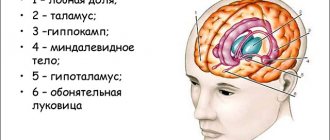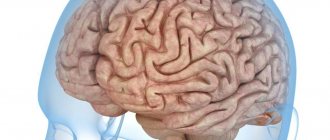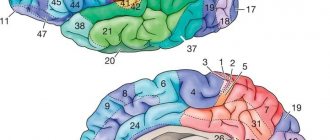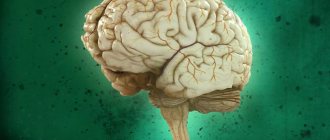The question of how much a human brain weighs and how an individual’s intellectual abilities depend on its mass has interested scientists since ancient times. For example, Archimedes, who lived in 300 BC, calculated this indicator by immersing his head in a container of water and using the liquid that spilled out, using mathematical calculations, he calculated the estimated weight of this organ. This method, of course, did not give the true result, but the very fact that they were interested in this back in those days is amazing.
At the moment, it is known that the mass of a person’s brain is approximately equal to 2% of the weight of the entire body, however, such a judgment is inaccurate, since the indicator changes throughout life and depends on many factors.
Differences between men and women
It is impossible to answer the question of exactly how much the adult brain weighs without weighing this organ, which is possible only after the death of the subject. At the same time, existing average statistical data can only give an approximate idea of this value.
So, the brain mass of an ordinary middle-aged person ranges from 1100 to 2000 g. This variation is due to various factors affecting the development of the body. It is known that the mass of the human brain depends on the gender, age and race of the individual.
Thus, men may well make fun of the weaker sex about the fact that their brains weigh 100-150 g more, however, this fact does not allow us to judge mental abilities and speaks about the structural features of the central nervous system: in men there is a connection between the perception of reality and coordination movements are better, therefore spatial and motor activity is developed, as evidenced by the development of zones responsible for performing these functions. And women have more developed intuition and associative thinking, which allows them to quickly process incoming information and find easier ways to solve problems.
Gender characteristics
In men, there is an increased volume of brain matter - white and gray. Women have smaller tonsils. Research shows the presence of gender differences in the anatomical organization of the analyzers - auditory and visual. In the male population, an excess of the neuronal resource of the visual cortex is observed. In the female group, the volume of neuronal structures of the auditory cortex was exceeded.
Similar studies served as the basis for the assertion that men perceive external information better with their eyes, and women with their ears. A number of studies have shown the presence in women of large cortical structures responsible for the formation of emotional reactions. In men, interhemispheric asymmetry is more pronounced.
Taking into account the dependence of brain mass on body mass, scientists have identified structural and morphological differences that are related to features of functioning. For example, there are some sex differences in the structure of the brain matter in the post-resuscitation period after experiencing clinical death.
During experiments on animals, it was established that in the population of males and females after resuscitation, different localization and different sizes of areas of damaged nervous tissue are revealed with the same duration of cardiac arrest. In males, a more extensive area of damage is observed, which covers the cerebellum, hippocampus, and segments of the sensorimotor cortex.
In females under similar conditions, damage to the nervous tissue is predominantly detected in the hippocampus. At the same time, females exhibit a less pronounced neurological deficit, and the process of regression of neurological symptoms occurs more quickly.
Other studies after an episode of artificial ischemia, reperfusion (impairment of blood flow) of the brain of various origins and subsequent restoration of blood supply in the medulla also confirmed higher damage to nervous tissue in males than in females.
Brain Development
The human brain is part of the central nervous system, which controls the vital functions of the body. A large number of psychologists, doctors and other specialists are working on the study of this organ, studying the structure and connection of its integrity with the functioning of the physiological systems of the body.
The usual dimensions of the brain are 20x20x15 cm, and it has a complex structure, and each section includes several types of neurons.
As already written earlier, the average weight of the human brain ranges from 1100-2200 g, but generally falls within the range of 1100-1500 g, and reaches its maximum weight by the age of 27, and then gradually begins to decrease, losing an average of 1 year for 3 years
Prenatal development
The formation of the central nervous system during the intrauterine period of a child’s life begins in the 3rd week after fertilization of the egg. In this case, the neural plate first develops from the outer germ layer, which bends over time to form the neural groove. The edges of this gyrus fuse to create the fetal neural tube, from the front of which the child's brain is formed. In this case, the end of the tube is first divided into 3 sections or 3 primary brain vesicles. From the first, the cerebral hemispheres and the intermediate section are formed, from the second - the middle, and from the last - the cerebellum, pons and medulla oblongata.
The development of the brain in the prenatal period occurs in parallel with the maturation of other structures, and the most ancient parts are formed faster and more actively, therefore, in a healthy newborn child, when born, unconditioned reflexes such as breathing, swallowing, etc. are fully functioning, and the weight of this organ at the time of birth is approximately 300-500g.
Natal state
Further development of the functions of the central nervous system continues after birth, and at the end of the first year of a child’s life, the mass of the brain located in the cranial cavity is approximately 1000 g. In an adult, this figure fluctuates around 1300 g. Based on this, it becomes obvious that the largest the rate of increase occurs in the first year of life.
By this time, the subcortical structures are almost completely formed, and the mass of the organ grows due to the division of glial cells and an increase in the number of dendritic branches, while the number of neurons remains the same, since they stop dividing during intrauterine development.
During this period, the final maturation of the projection areas originating from the receptors of the sensory organs and motor pathways occurs, while the greatest development occurs in the structures responsible for the regulation of the motor system and the activity of brain activity.
Period from 2 to 5 years
During this period, the weight of the brain increases due to the development of areas responsible for spatial orientation and purposeful movement, as well as complex psychological processes such as thinking, memory, and the assimilation of information received from the outside world.
Period from 5 to 7 years
The fields of the human brain responsible for the ability to learn and remember are the last to mature. Moreover, all mental processes occurring in the child’s brain (perception, attention, memory, thinking and imagination) are associated primarily with the development of speech, which in turn is formed under the influence of these functions.
Thus, the development of the brain occurs in several stages, and a failure in the formation of one of the levels entails a disruption in the maturation of the structures of the next stage and, as a result, mental and behavioral deviations.
Hearing, smell, touch
“Hello, I can’t hear you!”
The human middle ear contains 2,500 cells that respond to sounds. The upper limit of the frequencies we perceive reaches 16–20 million hertz. Over the years, the ear's sensitivity, especially to high-pitched sounds, decreases.
Tasty when +24ºС
On the surface of the tongue there are about 9,000 nerve endings that respond to taste. They function best at 24ºC.
Small, but smart
The surface of the olfactory zone of the nose is only 5 cm2, but it contains about 1,000,000 nerve endings. The sensation of smell occurs when at least 40 nerve endings are excited.
That's why he's freezing!
The coldest part of the human body is the nose. The temperature of its tip usually does not exceed +22ºС.
Comparison of human and animal brains
The brain mass of various fauna representatives depends on a huge number of factors. For example, amphibians and ancient lizards cannot boast of the heaviness of this organ: the weight of a dinosaur's brain, despite its rather large dimensions, was approximately 1000g.
If we compare this indicator in mammals and humans, the data will also vary: For example, the weight of the brain of an elephant ranges from 4000 g to 5000 g, and the largest brain mass is recorded in the blue whale - about 9000 g.
The most sociable animal is the dog, which has a brain weighing no more than 100g, which does not prevent these representatives of the animal world from responding well to training; it is not without reason that Academician Pavlov chose them to study unconditioned reflexes.
As can be seen from the above, the mass of the brain matter of animals does not affect their mental abilities, but in humans it is the opposite: too much weight of an adult’s head indicates the development of pathology. Therefore, we can conclude that the level of intelligence depends only to a lesser extent on the ratio of brain mass to body mass: therefore, animals with a high indicator are better amenable to training and, accordingly, are easier to control.
"The Study of Human Varieties"
On the eve of the exhibition, Dmitry Anuchin in the newspaper “Russkie Vedomosti” convinced his compatriots, for whom the very thought of man as a subject of zoological research seemed blasphemous:
“Without extensive practice and special study, it is very difficult to distinguish between individual breeds of horses, sheep, cattle, pigs, dogs, and to judge the greater or lesser degree of purity and mixture of these breeds. We encounter a similar difficulty when studying human varieties, and if it is considered understandable and natural that the study of, for example, horse breeds can form the subject of a special branch of knowledge, “hippology,” then all the more reason do we have reason to recognize it as rational to separate it into a separate science of study breeds of humanity... The study of tribes cannot be limited to morphology alone, i.e., knowledge of external appearance and external forms, but must extend to the totality of the organization and include the study of anatomical and physiological features. Only in this way can we hope to form a more definite concept of the tribal differences that exist between people and to penetrate deeper into the understanding of the essence and origin of these characteristics."
Anuchin also pointed out that detailed knowledge about humanity is most needed by humanity itself. But in reality, the research brought scant scientific and almost zero political results.
Significant efforts to collect information about the average height of Russian army recruits have shown how insignificant this growth is according to modern ideas
Photo: RGAKFD/Rosinform, Kommersant
The first attempts at the practical use of anthropology were associated with physiognomy - the science of recognizing a person’s character by his appearance. However, the idea of connecting it with anthropology in Russia led nowhere. Russian physiognomists bitterly stated that the famous Russian ethnographer and writer Sergei Vasilievich Maksimov was right:
“The Great Russian tribe is distinguished precisely by the fact that it is difficult to find one person similar to another, which we often find not only among wandering northern foreigners and nomadic steppe inhabitants, but also among the southern highlanders, and especially among the Transcaucasian and Russian Armenians . Even at the smallest fair, in a small bazaar, anyone can easily convince himself that nothing is more difficult than to find such features that could be considered common, and to define and clarify for himself such a law that would be convenient be used to recognize the tribal differences of the Great Russians... Hardly the dialect alone can still be considered among the common special signs.”
Moscow University professor Anatoly Petrovich Bogdanov tried to identify common features by photographing and comparing images, but failed completely. In 1878 he wrote:
“If you come across a physiognomy that is quite interesting as an expression of a Russian face, then in 99 cases out of a hundred it is impossible to get a portrait from it due to the refusal to allow you to take a portrait of yourself in front and profile... I had to limit myself to a very close circle of more familiar faces who, as a favor, agreed to satisfy a strange demand, from which they did not expect anything worthwhile, but agreed out of a desire not to contradict the harmless mania of a friend and loved one.”
“If it is considered natural that the study of horse breeds can form the subject of a special branch of knowledge, then all the more reason do we have reason to recognize as rational the isolation of the study of human breeds into a separate science”
Other researchers who decided to study anthropology also experienced considerable problems. In 1879, the Moscow doctor Vasily Nikolaevich Benzengr, who was carried away by the new direction, described his attempts to collect information from patients:
“Obtaining information is fraught with the greatest difficulties... The proposed questions very often brought color to the face of the patient, especially the young one. In general, we are so little accustomed to calling things by their proper names, and our women are even less accustomed to speaking calmly about their physiological functions, that only positive assurances that all this information is necessary for the correct treatment of a real illness could force them to give the necessary answers... Therefore, I I cannot in any way vouch for the complete veracity of the answers, especially in some truly very sensitive issues; the figure of silence was used by my patients more often than I would like.”
The information collected by Benzengr from 1866 to 1875 was of some interest for demography. Only a quarter of his patients turned out to be natives of Moscow: the vast majority came to the Mother See from the Moscow and adjacent provinces. In addition, it was not uninteresting that during all the time he saw only two peasant women over 75 years old, and many working women over 50 years old, by appearance and state of health, were classified as old women.
Significant efforts to collect information about the average height of Russian army recruits have shown how insignificant this growth is according to modern ideas
Photo: RGAKFD/Rosinform, Kommersant
However, despite the fact that the doctor collected data on 5,611 patients over ten years, the result of his research for anthropology was, to put it mildly, not entirely impressive. The main conclusion of the study was:
“We consider ourselves fully entitled to say that the early sexual development of a Russian woman is her racial anthropological sign.”
Even less successful was the anthropological study of the Lithuanians conducted in 1887 by Nikolai Andreevich Yanchuk, whose political goals were almost not hidden in his report:
“Until the 12th century. Lithuanians were almost always subordinate to the Slavs, and only from the 12th century. the independent life of Lithuania begins, which over the course of several centuries reached a fairly flourishing development and then again fell under the blows of stronger neighbors - the Slavs and Germans... Based on the data presented by the language, researchers conclude that the Lithuanian and Slavic nationalities once formed one Litho-Slavic branch Indo-European tribe. From this one whole came two branches: Lithuanian and Slavic, and each of them began to exist separately, develop and split into dialects and nationalities.”
It remained to finally prove the legitimacy of the Lithuanians and their lands being part of the Russian Empire - with the help of anthropology. Yanchuk compared Lithuanians with Belarusians both in eye color and hair color and came to the conclusion that Lithuanians and Belarusians are very close to each other. But he still did not draw final conclusions in favor of the common origin of the two peoples:
“I have studied a relatively very small area, one locality of Lithuania... Therefore, it may easily turn out that those few particular generalizations that I pointed out will not be justified in further studies of Lithuanians by other persons. We noticed that in some respects (hair and eye color, head shape) in general the Lithuanian comes close to the Belarusian; but at the same time, regarding particulars, much greater diversity is noticeable in the type of Belarusians than in the type of Lithuanians. What follows from this? Does the close similarity or sameness of physiological traits of Lithuanians and Belarusians indicate that Lithuanians are of purely Slavic origin? It’s hard to say, if only because it’s unlikely that a Belarusian himself can be considered a pure Slavic type and serve as a model for comparison...”
Relationship between brain weight and intelligence level
To answer the question of how much the average adult brain weighs and how intelligence affects brain weight, scientists had to do a lot of work studying this organ. Thus, for normal functioning, the neurons of the central nervous system need to consume at least 30% of the oxygen supplied through the lungs, and its deficiency leads to the extinction of brain activity and damage to the cells and structures of this organ, respectively, to a decrease in its weight. It is known that following a decrease in physical activity, the acuity of a person’s mental abilities decreases, so older people are prone to memory disorders and they lose the ability to think logically.
The theory that the weight of the adult brain does not affect intelligence was confirmed by studies of this organ in people suffering from mental disorders: for example, the largest brain weighing 2800 g belonged to a weak-minded person, while the brain weight of geniuses did not differ from the average statistical data. This is explained by the fact that the development of abilities is influenced by the structural features of the cortical structures, and the denser the network of its neurons, the more talented the individual, while an increase in other structures leads to a deviation in mental abilities.
Studies conducted on people with microcephaly have shown that these individuals are able to lead a simplified social life, but they always required outside care.
Vision
Complex optical device
Up to 14 months in newborn girls and up to 16 months in boys, there is a period of complete non-perception of colors. Then the perception of red appears, then green, and even later blue. The formation of color perception ends at 7.5 years in girls and by 8 years in boys. The eye is able to distinguish 130–250 pure colors and 5–10,000,000,000 mixed shades.
After an hour in the dark
After one hour in the dark, the light sensitivity of the eye increases 200 times.
Rods and cones
The human retina contains 125,000,000 rods and 6,500,000 cones, and together they are so sensitive that a person could theoretically see the light of a candle at a distance of 200 kilometers.
Brain mass of some famous people
The heaviest brain in a physically and mentally healthy person was described in the 19th century by the German naturalist Rudolphi, and was 2.222 kilograms, which makes it possible to judge that the average weight of the brain ranges from 1000-2200 g.
An examination of the brain matter of famous people confirms the theory that the weight of the brain does not affect genius, since this indicator does not go beyond the established limits:
- Vladimir Mayakovsky, Soviet poet - 1.7 kg;
- Albert Einstein, theoretical physicist - 1.23 kg;
- Otto von Bismarck, politician -1.97 kg;
- Vladimir Lenin (Ulyanov), politician -1.34 kg;
- Ludwig van Beethoven, composer -1.75 kg;
- Anatole France, literary critic and writer - 1.02 kg;
- Ivan Turgenev, writer - 2.01 kg;
- Carl Friedrich Gauss, German physicist, mathematician - 1,492 kg.
At the same time, a detailed examination of the structures of this organ revealed the dependence of the development of areas of the cortex responsible for creative thinking or a mathematical mindset on the demonstrated abilities.
Smoking
Indian scientists, after a series of studies, came to the conclusion that smoking has a detrimental effect on the brain, destroying it. The main destructive force is tobacco, since the brain receives too little oxygen due to tobacco smoke. In addition, several thousand different chemical compounds enter the brain from cigarettes and tobacco smoke, 30 of which are especially toxic.
From the editor: Will disability be removed after treating epilepsy with cells?
After nicotine enters the brain from the lungs, a person experiences an increase in mental activity, since nicotine excites nerve cells, prompting them to work. However, after a while the opposite effect occurs. There is a narrowing of its blood vessels, as a result of which the supply of oxygen and nutrients to the nerve cells is disrupted, which manifests itself in the form of headaches.
In the future, this may cause the development of cancer.
Due to smoking, the blood vessels of the brain lose their firmness and elasticity, which leads to impaired cerebral circulation and, with a number of accompanying factors, to hemorrhage in the brain.
Smoking is often a cause of multiple sclerosis.











